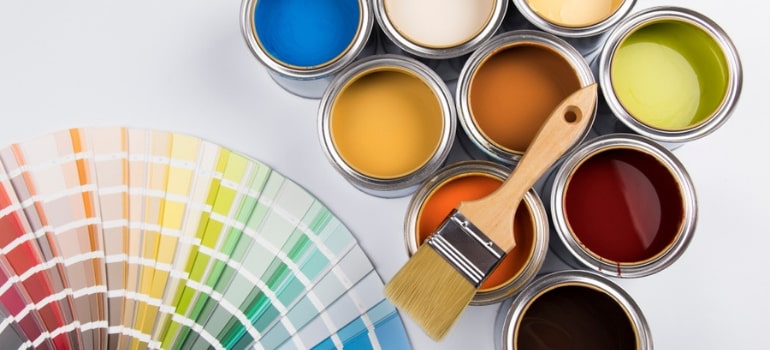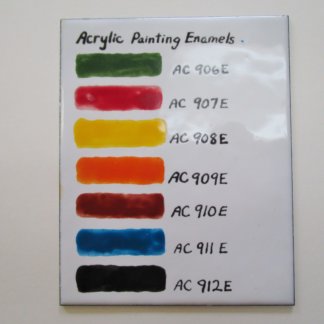Yes, you can paint acrylic over enamel if the enamel surface is properly prepared. A primer designed for acrylic paint is necessary to ensure adhesion.
Painting acrylic over enamel can be a viable option for artists and DIY enthusiasts looking to explore different media or update a project. This approach offers flexibility and the opportunity to harness the properties of both types of paint. Before starting, it’s critical to understand the preparation process to avoid any potential issues such as cracking or peeling.
A well-prepared enamel surface provides a sturdy base for the acrylic paint, which can then be applied to create a vibrant, long-lasting finish. Whether you’re working on a canvas, a piece of furniture, or a model, the key to success lies in meticulous surface preparation and the use of compatible primers. With the right technique, materials, and a bit of patience, you can achieve professional-looking results by combining these two popular painting mediums.

Credit: fantastichandyman.com.au
Contents
- Introduction To Acrylic And Enamel Paints
- Key Differences Between Acrylic And Enamel
- The Possibility Of Painting Acrylic Over Enamel
- Pre-painting Considerations
- Step-by-step Guide To Applying Acrylic Over Enamel
- Expert Tips For A Smooth Application
- Potential Problems And Solutions
- Protecting Your Acrylic Over Enamel Work
- Frequently Asked Questions
- Conclusion
Introduction To Acrylic And Enamel Paints
Crafters, artists, and DIY enthusiasts often explore different paint types for their projects. Two popular choices are acrylic and enamel paints. Each has unique features, suitable for varied applications. Knowing their characteristics helps in deciding whether you can paint acrylic over enamel.
Characteristics Of Acrylic Paint
Acrylic paint is a water-based medium known for its versatility and ease of use. It dries quickly, allowing for rapid layering and blending. Here are its key characteristics:
- Quick drying time: Acrylic paint typically dries within minutes.
- Water-soluble: Easily mixed and cleaned with water.
- Flexible: Adapts to a variety of surfaces without cracking.
- Bright colors: Offers a wide range of vibrant hues.
Properties Of Enamel Paint
Enamel paint, often oil-based, is known for its durability and glossy finish. It is commonly used for surfaces that require a tough, long-lasting coat. Its properties include:
- High durability: Resistant to wear and tear.
- Slow drying: Takes hours to days to fully cure.
- Hard finish: Creates a tough, glossy layer.
- Excellent coverage: Often requires fewer coats.
Key Differences Between Acrylic And Enamel
Understanding the key differences between acrylic and enamel paints is crucial for any DIY enthusiast or professional painter. These differences impact how each paint type is used, its durability, and the final finish. Let’s dive into the specifics of chemical composition and drying times to help you decide which paint is best for your next project.
Chemical Composition
The chemical makeup of a paint determines its properties and how it interacts with surfaces. Acrylic paint is water-based, making it easy to clean up and eco-friendly. Enamel paint, on the other hand, is oil-based, known for its hard, glossy finish. Here’s a comparison:
- Acrylic: Water as the primary solvent
- Enamel: Oil-based with chemical solvents
Drying Time And Application
Drying time and application methods are crucial when working with paint. Acrylics dry quickly due to water evaporation, allowing for rapid layering. Enamels take longer to dry, needing more time between coats. This affects project timelines:
| Paint Type | Drying Time | Application Tips |
|---|---|---|
| Acrylic | Fast-drying | Multiple coats in a single day |
| Enamel | Slow-drying | Wait longer between coats |
The Possibility Of Painting Acrylic Over Enamel
Many artists ask about the possibility of painting acrylic over enamel. It’s a common question, especially for those who want to add new life to an old project. The short answer is yes, but there are some important steps to ensure the paint adheres properly and looks great.
Compatibility Issues
Acrylic and enamel paints don’t mix well. Enamel is an oil-based paint, while acrylic is water-based. This difference can lead to issues if the proper steps are not followed. Before attempting to apply acrylic over enamel, understand the risks such as peeling, cracking, or not drying correctly. Compatibility is key for a successful paint job.
Surface Preparation Essentials
Preparing the enamel surface is crucial. Start by cleaning the surface thoroughly. Use a degreaser to remove any oil or grease. Next, sand the enamel lightly with fine-grit sandpaper. This step creates a texture that helps the acrylic paint to grip. Wipe away the dust after sanding. Apply a primer designed for acrylic paint. Let the primer dry completely before proceeding with the acrylic paint application.

Credit: www.reddit.com
Pre-painting Considerations
Before you brush the first stroke of acrylic, considering a few key points ensures a lasting finish. Transforming a surface painted with enamel requires prep. This process goes beyond grabbing a paintbrush and a new color. Let’s dive into the pre-painting essentials.
The State Of The Enamel Surface
Inspect the enamel surface before proceeding. Check for chips, cracks, or peeling. These flaws need addressing to achieve a smooth foundation. Here’s a checklist:
- Clean the surface with mild soap and water.
- Rinse thoroughly and let it dry.
- Sand the surface lightly to create a key for the new paint.
- Wipe off the dust from sanding.
Is the enamel glossy? A light sanding helps acrylic paint adhere better. Ensure the surface is clean and dry before painting.
Intended Use Of The Object
Consider how the object will be used. Will it be indoors or outdoors? Exposed to heat or moisture? These factors influence the choice of paints and methods. For items in high-traffic areas, durability is key. Use a primer designed for acrylic over enamel. This table illustrates the best practices:
| Location | Primer Needed | Top Coat |
|---|---|---|
| Indoors | Optional | Not Required |
| Outdoors | Yes | Sealant Recommended |
| High Heat | Specialized | Heat-resistant |
For outdoor objects, protect the new acrylic layer. Apply a sealant to guard against weather. For kitchen items, use heat-resistant options. A correct approach extends the life of your work.
Step-by-step Guide To Applying Acrylic Over Enamel
Welcome to our step-by-step guide on applying acrylic over enamel. Whether you’re a hobbyist or a professional, this guide will help you achieve a flawless finish on your projects. We’ll cover everything from cleaning to priming, so let’s dive in!
Cleaning The Enamel Surface
Before anything else, clean the enamel surface thoroughly. Dirt, grease, or wax can prevent proper adhesion. Here’s how to prep your surface:
- Wipe down the surface with a degreaser.
- Use a clean cloth to remove all residue.
- Ensure the surface is completely dry before proceeding.
Sanding For Adhesion
Sanding creates a rough surface for the acrylic to grip. Follow these steps for effective sanding:
- Start with a medium-grit sandpaper (around 150-200).
- Sand the enamel surface gently and evenly.
- Wipe away the dust with a tack cloth.
Priming The Surface
Priming is crucial for a uniform paint job. Here’s how to prime your surface properly:
| Step | Action | Tip |
|---|---|---|
| 1 | Choose a high-quality primer that’s compatible with acrylic paint. | Read the label to confirm compatibility. |
| 2 | Apply the primer in thin, even coats. | Let each coat dry completely before the next. |
| 3 | After priming, sand the surface lightly with fine-grit sandpaper. | This will ensure a smooth base for painting. |
With these steps complete, your enamel surface is ready for acrylic paint application. Remember, patience and attention to detail will lead to the best results!
Expert Tips For A Smooth Application
Many artists and DIY enthusiasts ask: Can you paint acrylic over enamel? Yes, with the right approach. Let’s explore expert tips for smooth application.
Avoiding Common Pitfalls
Preparation is key when applying acrylic paint over enamel. Here’s what to avoid:
- Skipping surface cleaning: Remove all grease and dirt for better adhesion.
- Ignoring primer: A suitable primer ensures the acrylic paint sticks well.
- Applying thick layers: Thick paint may crack. Use thin, even coats instead.
Techniques For Even Coverage
For a professional-looking finish, apply these techniques:
- Sanding: Gently sand the enamel surface for a rough texture that grips the paint.
- Thin coats: Apply multiple thin layers of acrylic paint, letting each dry thoroughly.
- Consistent strokes: Use uniform brush strokes or a roller for an even look.
Remember, patience leads to stunning results.
Potential Problems And Solutions
When attempting to paint acrylic over enamel, a few issues can arise. Understanding these problems helps in finding the right solutions. Let’s explore some of the common challenges and their fixes.
Peeling And Cracking
Peeling and cracking often occur when layers don’t bond. Acrylics may not stick well to the glossy surface of enamel. To prevent this:
- Sand the surface to create a rough texture for better adhesion.
- Apply a compatible primer as a base.
- Ensure the enamel layer is fully cured before painting over.
Color Bleeding And Opacity Issues
Color bleeding and opacity issues can spoil your finish. Acrylic paint may not cover enamel evenly. To combat this:
- Use high-opacity acrylics for better coverage.
- Apply multiple thin coats, allowing each to dry fully.
- Consider using a sealer to lock in the enamel color.
Protecting Your Acrylic Over Enamel Work
When you’ve completed a masterpiece by painting acrylic over enamel, protection is key. The right sealing techniques ensure longevity and vibrance. Discover how to shield your artwork effectively.
Sealing The Paint
Sealant is essential for your acrylic over enamel art. It prevents chipping and peeling. Use a clear acrylic sealant. This adds a protective layer. It keeps the colors bright. Always apply sealant in a well-ventilated area. Allow it to dry completely.
Choose between matte and gloss finishes. Matte sealants reduce glare. Gloss sealants enhance colors. Both provide strong protection. Apply sealant with a soft brush. Cover the entire surface evenly. Let each coat dry before adding another.
Maintenance And Care
Maintaining your artwork is straightforward. Dust it gently with a soft cloth. Avoid harsh chemicals. They can damage the sealant and paint. Clean spills immediately. Use a damp cloth, then dry the surface.
Display your art wisely. Keep it away from direct sunlight. UV rays can fade colors over time. Hang your painting in a stable environment. Avoid areas with extreme temperature changes. This will prevent the paint from cracking.
Remember, regular checks are important. Look for signs of wear. Touch up the sealant if needed. With proper care, your acrylic over enamel artwork will stay vibrant for years.

Credit: thompsonenamel.com
Frequently Asked Questions
Can You Put Acrylic Paint On Top Of Enamel Paint?
Yes, you can apply acrylic paint over enamel paint, but ensure the surface is clean and dull for proper adhesion. It’s advisable to do a small test area first.
Can You Paint Acrylic Over Oil Enamel?
No, you should not paint acrylic over oil enamel as it can lead to poor adhesion and peeling. Acrylic paint requires a surface that can breathe, which oil-based paints do not provide.
Can Acrylic Clear Go Over Enamel?
Yes, you can apply an acrylic clear coat over an enamel base paint. Ensure the enamel paint is fully cured before applying the clear coat for best results.
Can You Use Enamel And Acrylic Paint On The Same Model?
Yes, you can use both enamel and acrylic paints on the same model. Ensure acrylic paint dries completely before applying enamel. Seal each layer with a clear coat to prevent reactions. Always test on a small area first.
Conclusion
Wrapping up, painting acrylic over enamel is possible with the right preparation. Remember to thoroughly clean and sand the surface before you begin. By following the steps we’ve outlined, your project should result in a smooth, durable finish. Embrace your creativity and give your items a fresh, new look!
